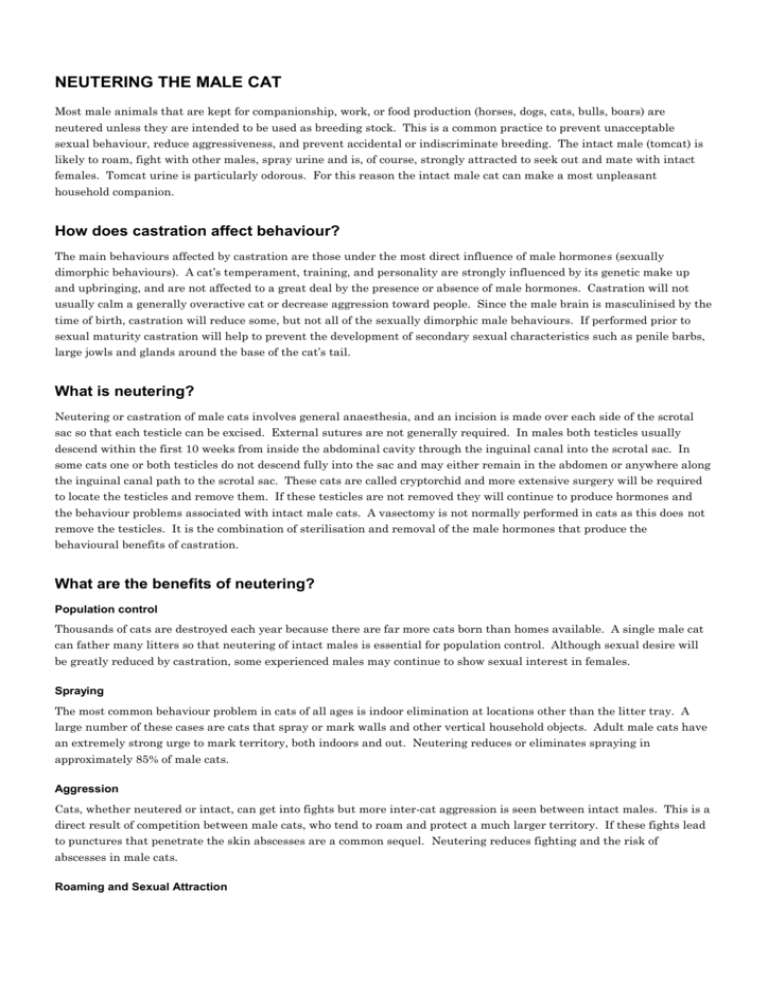
NEUTERING THE MALE CAT
Most male animals that are kept for companionship, work, or food production (horses, dogs, cats, bulls, boars) are
neutered unless they are intended to be used as breeding stock. This is a common practice to prevent unacceptable
sexual behaviour, reduce aggressiveness, and prevent accidental or indiscriminate breeding. The intact male (tomcat) is
likely to roam, fight with other males, spray urine and is, of course, strongly attracted to seek out and mate with intact
females. Tomcat urine is particularly odorous. For this reason the intact male cat can make a most unpleasant
household companion.
How does castration affect behaviour?
The main behaviours affected by castration are those under the most direct influence of male hormones (sexually
dimorphic behaviours). A cat’s temperament, training, and personality are strongly influenced by its genetic make up
and upbringing, and are not affected to a great deal by the presence or absence of male hormones. Castration will not
usually calm a generally overactive cat or decrease aggression toward people. Since the male brain is masculinised by the
time of birth, castration will reduce some, but not all of the sexually dimorphic male behaviours. If performed prior to
sexual maturity castration will help to prevent the development of secondary sexual characteristics such as penile barbs,
large jowls and glands around the base of the cat’s tail.
What is neutering?
Neutering or castration of male cats involves general anaesthesia, and an incision is made over each side of the scrotal
sac so that each testicle can be excised. External sutures are not generally required. In males both testicles usually
descend within the first 10 weeks from inside the abdominal cavity through the inguinal canal into the scrotal sac. In
some cats one or both testicles do not descend fully into the sac and may either remain in the abdomen or anywhere along
the inguinal canal path to the scrotal sac. These cats are called cryptorchid and more extensive surgery will be required
to locate the testicles and remove them. If these testicles are not removed they will continue to produce hormones and
the behaviour problems associated with intact male cats. A vasectomy is not normally performed in cats as this does not
remove the testicles. It is the combination of sterilisation and removal of the male hormones that produce the
behavioural benefits of castration.
What are the benefits of neutering?
Population control
Thousands of cats are destroyed each year because there are far more cats born than homes available. A single male cat
can father many litters so that neutering of intact males is essential for population control. Although sexual desire will
be greatly reduced by castration, some experienced males may continue to show sexual interest in females.
Spraying
The most common behaviour problem in cats of all ages is indoor elimination at locations other than the litter tray. A
large number of these cases are cats that spray or mark walls and other vertical household objects. Adult male cats have
an extremely strong urge to mark territory, both indoors and out. Neutering reduces or eliminates spraying in
approximately 85% of male cats.
Aggression
Cats, whether neutered or intact, can get into fights but more inter-cat aggression is seen between intact males. This is a
direct result of competition between male cats, who tend to roam and protect a much larger territory. If these fights lead
to punctures that penetrate the skin abscesses are a common sequel. Neutering reduces fighting and the risk of
abscesses in male cats.
Roaming and Sexual Attraction
Intact males have much larger territories and wander over much greater distances than females and neutered males.
The urge to roam may be particularly strong during mating season. Castration reduces roaming in approximately 90% of
cases. Neutering greatly reduces sexual interest, but some experienced males may continue to be attracted to, and mate
with females.
Physical Changes
Male urine odour is particularly strong and pungent. Castration leads to a change to a more normal urine odour. Many
owners claim that their intact males become much cleaner, less odorous, and better self-groomers after neutering.
Abscess formation as a result of fighting is far less frequent and some of the secondary sexual characteristics such as the
over-productive tail glands in the condition known as "stud tail" can be dramatically improved.
Does neutering lead to any adverse effects on health or behaviour?
There are many misconceptions about the effects of neutering on health and behaviour. Neutered males are no more
likely to become fat or lazy provided they receive a proper diet and adequate exercise. With less roaming and fighting
and mating, calorie intake may have to be reduced and alternative forms of play and activity provided. Behaviours that
have developed independent of hormonal influences such as hunting are not affected. Although neutering prior to
puberty appears to have similar effects to neutering post-puberty, every attempt should be made to neuter prior to
puberty before the cat develops problem behaviours.
Ark Veterinary Centre





